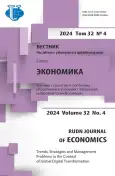Формирования китайского рынка легкового автомобилестроения
- Авторы: Кеося Н.Д.1
-
Учреждения:
- Российский университет дружбы народов
- Выпуск: Том 32, № 4 (2024): ТРЕНДЫ, СТРАТЕГИИ И ПРОБЛЕМЫ УПРАВЛЕНИЯ В УСЛОВИЯХ ГЛОБАЛЬНОЙ ЦИФРОВОЙ ТРАНСФОРМАЦИИ
- Страницы: 657-672
- Раздел: ЭКОНОМИКА ОТРАСЛЕВЫХ РЫНКОВ
- URL: https://journal-vniispk.ru/2313-2329/article/view/324269
- DOI: https://doi.org/10.22363/2313-2329-2024-32-4-657-672
- EDN: https://elibrary.ru/KWPVWG
- ID: 324269
Цитировать
Полный текст
Аннотация
Китай является абсолютным лидером на мировом рынке автомобилестроения: в 2023 г. было произведено и продано более 30 млн единиц. Не последнюю роль в данном лидерстве Китая сыграло размещение производства за рубежом. Однако китайские производители автомобилей сталкиваются с усилением международной конкуренции, в т.ч. и со стороны США, которые занимают второе место по показателю производства за 2023 г. В частности, в конце 2022 г. в США был принят резонансный закон «О сокращении инфляции», направленный не только на стимулирование рынка труда, но и поддержку сектора автомобилестроения и, главным образом, в области производства электромобилей. Китай также занимает одно из ведущих мест на мировом рынке электромобилей, которое обеспечивается посредством совокупности ряда принципов, среди которых: рыночный характер развития; инновационный характер развития; координация осуществления экономической деятельности; открытость китайских компаний к международному сотрудничеству. Цель исследования заключается в выявлении особенностей развития китайского рынка автомобилестроения. Проводится анализ основных мер, предпринятых китайским правительством для поддержки даного сектора, а также анализ основных участников, показателей их деятельностии и анализ вовлечения автомобилестроения в экспортную составляющую китайской экономики. На основе исторического и сравнительного анализа доказан тезис: за счет наличия ряда конкурентных преимуществ китайская автомобилестроительная промышленность оказалась гораздо более инвестиционно привлекательной, что обусловило ее быстрое развитие в сравнении с российской автомобилестроительной сферой. Выявлено, что одной из наиболее эффективных мер, предпринимаемых китайским правительством, является не столько масштабирование объемов производства, сколько внешнеэкономическая экспансия Китая на зарубежные рынки и интернализация производственного процесса. Также показано, что значительным недостатком китайского автомобилестроения является зависимость от иностранных комплектующих, что вынуждает сегодня китайское правительство в некоторой степени менять модель экономического равития и обращаться к импортозамещению.
Ключевые слова
Об авторах
Николай Дмитриевич Кеося
Российский университет дружбы народов
Автор, ответственный за переписку.
Email: 1142220545@rudn.ru
SPIN-код: 7761-0562
аспирант, кафедра международных экономических отношений, экономический факультет Российская Федерация, 117198, Москва, ул. Миклухо-Маклая, д. 6
Список литературы
- Babaev, K.V., Sazonov, S.L., & Ilyinskaya, I.D. (2023). Development of the automotive industry of the PRC and its prospects in the international market. ETAP: Economic Theory, Analysis, Practice, (3), 21–38. (In Russ.). https://doi.org/10.24412/2071-6435-2023-3-21-38
- Chen, B., Midler, C., & Ruet, J. (2018). The development of electric vehicles in China: Market facts and regulatory trends. Gérer et Comprendre, 131, 69–79.
- Chen, Y., & Wang, X. (2015). Geely automotive’s acquisition of Volvo. Asian Case Research Journal, 19(1), 183–202. https://doi.org/10.1142/S0218927515500078
- Deng, C. (2016). The role of the automotive industry in the process of exponential development of the PRC economy. Truck, (3), 34–38. (In Russ.).
- Dolanay, S.S. (2021). Rapid rise of China automotive industry in the 2000s and history of Turkey automotive industry. China-USA Business Review, 20(1), 46–64. https://doi.org/10.17265/1537-1514/2021.01.003
- Du, J., & Ouyang, M. (2013). Review of electric vehicle technologies progress and development prospect in China. World Electric Vehicle Journal, 6(4), 1086–1093. https://doi.org/10.3390/ wevj6041086
- Govorova, A.V. (2023). History and paradoxes of China’s car market: Eastern strategies and Asian regulator. Problems of forecasting, (1), 217–229. (In Russ.). https://doi.org/10.1134/ S1075700723010069
- Fang, T., & Chimenson, D. (2017). The internationalization of Chinese firms and negative media coverage: The case of Geely’ s acquisition of Volvo cars. Thunderbird International Business Review, 59 (4). https://doi.org/10.1002/tie.21905
- Heyes, A., & Kapur, S. (2009). An economic model of whistle-blower policy. Journal of Law, Economics and Organisation, 25(1), 157–182.
- Ibold, S., Xia, Y., & Xiao, S. (2021). NEV Development Plan 2035. Deutsche Gesellschaft für Internationale Zusammenarbeit. Beijing: Deutsche Gesellschaft für Internationale Zusammenarbeit.
- Kiryukhina, S.E., & Mikheshkina, E.Е. (2023). Chinese market of automotive industry: current state and prospects. RUDN Journal of Economics, 31(4), 723–739. (In Russ.). https://doi.org/10.22363/2313-2329-2023-31-4-723-739
- Li, Z. (2010). Future international business strategy of Chinese automotive manufacturers: A case study on their overseas operations in the Russian market. Annals of Business Administrative Science, 9, 13–32. https://doi.org/10.7880/abas.9.13
- Liang, Y., & Zhavoronkova, E. (2020). Trends and problems of the development of the PRC automotive industry. Innovations and Investments, (10), 41–46. (In Russ.).
- Luo, J. (2005). An Evaluation of the Governmental Protectionism Policies on the Chinese Passenger Car Industry in the 1980s~1990s. Working paper, International Motor Vehicle Program.
- Luo, J., Roos, D., & Moavenzadeh, J. (2006). The impact of government policies on industrial evolution: The case of China’s automotive industry. A revision from Jianxi Luo’s master thesis in technology and policy. Boston: MIT.
- Middlesworth, H. (2013). Engines of change: China’s rise and the Chinese auto industry. CMC Senior Thesis. 766.
- Sazonov, S.L. (2011). Plans of PRC guidelines for the creation of a new generation of cars on alternative energy sources. Transport on alternative fuel, (5), 42–45. (In Russ.).
- Sazonov, S.L., & Ilyinskaya, I.D. (2022). The market of flying electric cars in the PRC: myth or reality? ETAP: economic theory, analysis, practice, (6), 125–137. (In Russ.). https://doi.org/10.24412/2071-6435-2022-6-125-137
- Sazonov, S.L., & Chen, X. (2018а). Rapid development of alternative fuel vehicle production in the PRC. Alternative Fuel Transport, (2), 53–71. (In Russ.).
- Sazonov, S.L., & Chen, X. (2018б). China’s experience in the development of battery production and the infrastructure of fuel stations for electric vehicles, Alternative Fuel Transport, (3), 39–51. (In Russ.).
- Tang, R. (2012). China’s auto sector development and policies: Issues and implications. CRS Report for Congress: R40924.
- Wang, H. (2008). Innovation in product architecture — A study of Chinese cars made by Geely and its suppliers. Asia Pacific Journal of Management, 25(3), 509–535. https://doi.org/10.1007/ s10490-007-9084-x
- Yang, J., & Wang, Y. (2022). Competitiveness of China’s automotive industry and its development. Economics: yesterday, today, tomorrow, 12 (9A), 244–250. (In Russ.). https://doi.org/10.34670/AR.2022.73.62.065
- Zhang, Q. (2023). Strategy and inspiration of Great Wall Motor for overseas expansion. Economy and Society, (5), 813–820. (In Russ.).
Дополнительные файлы









